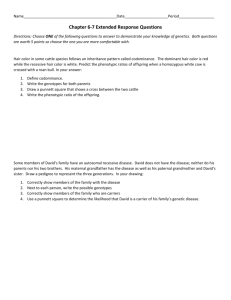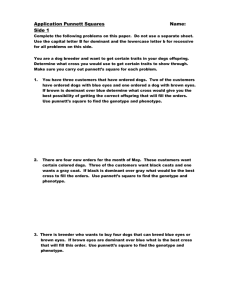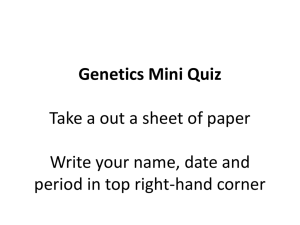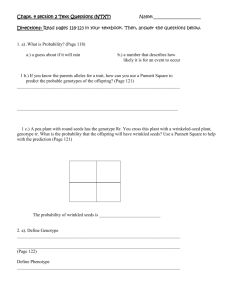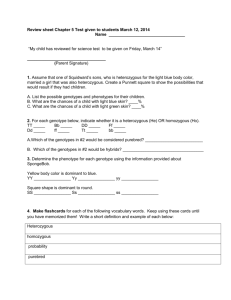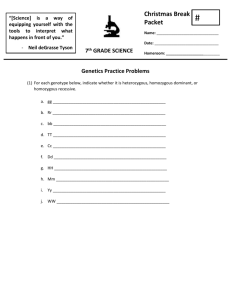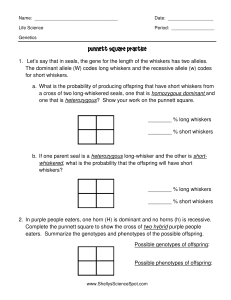Punnett Square Practice Problems
advertisement
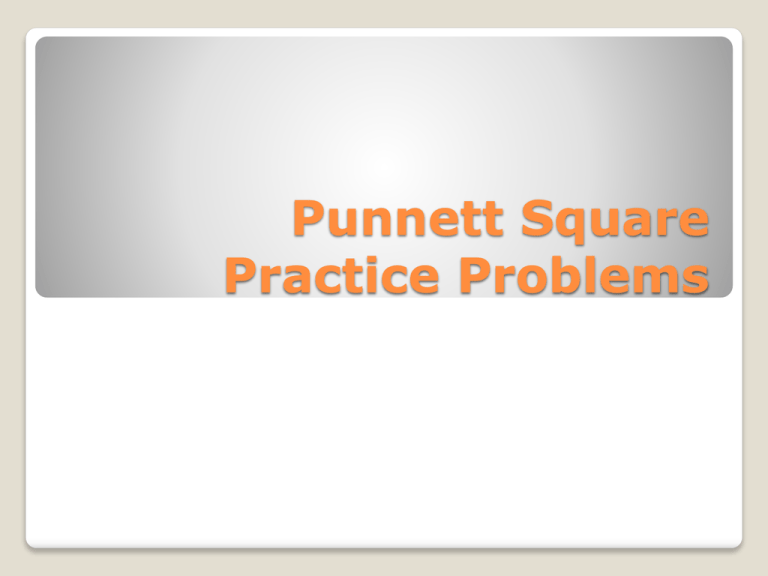
Punnett Square Practice Problems 1. Let’s say that in seals, the gene for the length of the whiskers has two alleles. The dominant allele (W) codes long whiskers & the recessive allele (w) codes for short whiskers. ◦ A. What percentage of offspring would be expected to have short whiskers from the cross of two long whiskered seals, one parent is purebred dominant and the other one is hybrid? ◦ B. If one parent seal is pure long whiskered and the other is short whiskered, what percent of offspring would have short whiskers? 2. In purple people eaters, one horn is dominant and no horn is recessive. ◦ A. Draw a Punnett Square showing the cross of a purple people eater that is hybrid for horns with a purple people eater that does not have horns. ◦ B. Summarize the genotype & phenotypes of the possible offspring. 3. A green-leafed fuzzywhatsit (I made this plant up) is crossed with a fuzzywhatsit with yellow-striped leaves. The cross produces 4 green-leafed fuzzywhatsits. ◦ A. What were the genotype of both parents? ◦ B. Summarize the genotypes & phenotypes of the offspring produced. 4. In dogs, there is a hereditary deafness caused by a recessive gene, “d”. A kennel owner has a male dog that she wants to use for breeding purposes if possible. The dog can hear, so the owner knows his genotype is either DD or Dd. If the dog’s genotype is Dd, the owner does not wish to use him for breeding so that the deafness gene will not be passed on. This can be tested by breeding the dog to a deaf female (dd). ◦ A. Draw the Punnett Square to illustrate the cross between Dd and dd. What percent of the offspring would be expected to be hearing? Deaf? ◦ B. Draw the Punnett Square to illustrate the cross between DD and dd. What percent of the offspring would be expected to be hearing? Deaf? ◦ C. Which gentype should the kennel owner be hoping for? Why? 5. In humans, brown eyes (B) are dominant over blue (b). A brown-eyed man marries a blue-eyed woman and they have three children, two of whom are brown-eyed and one of whom is blueeyed. ◦ A. Draw the Punnett Square that illustrates this marriage. ◦ B. What is the man’s genotype? ◦ C. What are the genotypes of the children? 6. In garden peas, round seed coats (R) is dominant over wrinkled seed coats (r). What will the result be of a cross between a purebred dominant male and a purebred recessive female? ◦ A. List the genotypes of the parents. ◦ B. Diagram and complete a Punnett Square ◦ C. Give the phenotype percentages of the offspring. 7. In peas, yellow color (Y) is dominant to green (y). What will be the results of a cross-pollination of a hybrid female and a hybrid male? ◦ A. List the genotypes of the parents. ◦ B. Diagram and complete a Punnett Square ◦ C. Give the phenotype percentages of the offspring. 8. In humans, straight toes (S) are dominant over curled toes (s). What would be the result of a cross between a recessive male and a purebred dominant female? ◦ A. List the genotypes of the parents. ◦ B. Diagram and complete a Punnett Square ◦ C. Give the phenotype percentages of the offspring. 9. In dogs, erect ears (E) are dominant over droopy ears (e). What are the results if two purebred recessive dogs have a litter of puppies? ◦ A. List the genotypes of the parents. ◦ B. Diagram and complete a Punnett Square ◦ C. Give the phenotype percentages of the offspring.
